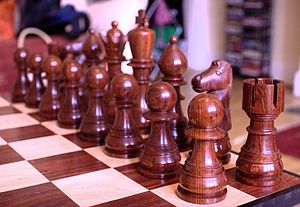Cocobolo

Cocobolo is a
Provenance
Cocobolo is yielded by two to four closely related species of the genus Dalbergia, of which the best known is Dalbergia retusa, a fair-sized tree, reported to reach 75–80 ft (23–24 m) in height and 3 ft (0.9 m) in diameter;[1] it probably is the species contributing most of the wood in the trade.[citation needed] Because of the high value of the timber, the trees yielding it have been heavily exploited, so they have become rare outside of national parks, reserves, and plantations. Only relatively small amounts of this prized wood reach the world market, and it is expensive.
Oil content
Cocobolo heartwood contains oil, which lends a strong, unmistakable floral odor even to well seasoned wood and occasionally stains the hands with prolonged exposure. The high natural oil content of the wood makes it difficult to achieve a strong glue joint, as in applying
Uses
Because it stands up well to repeated handling and exposure to water, a common use is for gun grips and knife handles, and duck calls. It is very hard, fine textured, and dense, yet easily machined. The abundance of natural oils, however, causes the wood to clog abrasives and fine-toothed saw blades, like other hard, dense tropical woods. Besides its use on guns and knives, cocobolo is favored for fine inlay work on custom, high-end cue sticks, police batons, pens, brush backs, bowls, pipes, jewelry boxes, desktops and other expensive specialty items.
Musical instruments
Due to its density and hardness, even a large block of the cut wood will produce a clear musical tone if struck. Renowned for its "warm, rich palette",
Conservation
Logs, sawn wood, and veneer sheets from the Guatemalan populations of Cocobolo (Dalbergia retusa), have been listed under CITES Appendix III[clarification needed] since 2008. In 2011, Panama extended that listing to include all products except seeds and pollen and finished products packaged and ready for retail trade.
As of January 2, 2017, Cocobolo is protected as a
In popular culture
- Paraguayan cocobolo was closely associated with David Woodard's iteration of the Dreamachine.[5]
- Jim Jarmusch's 2013 film Only Lovers Left Alive features a bullet fashioned from cocobolo and brass.[6]
- One plotline in the television show Better Call Saul revolves around the acquisition of a cocobolo desk.[7]
- A cocobolo log plays a prominent role in the "Dead Moon Walking Adventure" episode of The Great North.[8]
References
- ^ a b c "Cocobolo". Wood. Retrieved March 29, 2016.
- ^ ""DALBERGIA RETUSA"". Retrieved May 11, 2019.
- ^ "The Howarth XL Oboe" (PDF). Oboe Chicago. Retrieved 25 April 2017.
- ^ "Appendices". CITES. Retrieved 2018-09-26.
- ^ Allen, M., "Décor by Timothy Leary", The New York Times, January 20, 2005. Archived from the original on March 12, 2012.
- ^ Jarmusch, J., Only Lovers Left Alive screenplay, subslikescript.com, 2013.
- ^ Bowman, D., "Better Call Saul, 'Bingo'", The A.V. Club, March 16, 2015.
- ^ Scarlata, P., "'Dead Moon Walking Adventure' Transcript", TV Show Transcripts, April 10, 2022.
